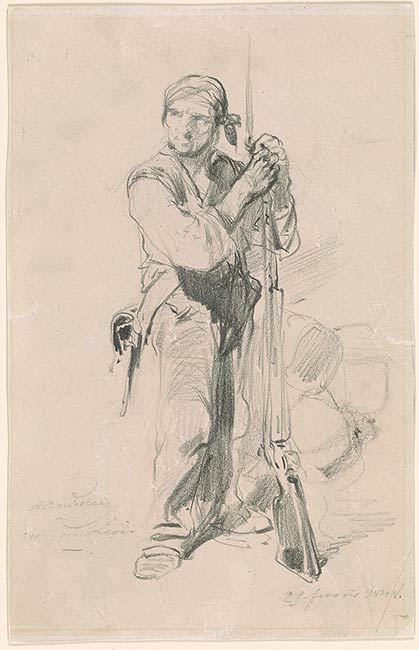
The inscription on this sheet was misread, and until 2023, it had been attributed to Pierre Andrieu, who worked as an assistant to Delacroix and is known for his drawings of animals. The signature is that of Clément-Auguste Andrieux, an artist of Belgian descent who specialized in scenes of conflict from the 1848 revolution to the Crimean War and the Franco-Prussian War, and siege of Paris. He regularly exhibited at the Salon from 1850 until his death in 1880 and saw his drawings and watercolors published in contemporary periodicals such as Le Monde illustré.
In February 1848, a civil uprising led to the collapse of the July Monarchy, the removal of the monarch Louis-Philippe, and the establishment of the Second Republic. During the uprising, the fourth revolution in sixty years, Paris saw the erection of barricades, an armed citizenry, protests, and violence. While quelled briefly, a second surge of fighting led to a state of siege in the city in June.
The artist dated this sheet 29 February 1848, indicating it was drawn just days after the uprising started, which peaked on 24-26 February. He drew men carrying a wounded comrade out of battle a few days earlier. Other drawings by Andrieux capture the actions of republican soldiers, suggesting that Andrieux was engaged in the events. He depicted a man dressed for fighting with his rifle and bayonet at the ready. The figure was a familiar one from the many paintings of the battles surrounding the 1830 revolution and also appears in Andrieux's watercolors depicting scenes from the 1848 conflict.
Watermark: none.
Signed, inscribed, and dated, at left, "P. Andrieu / a / mon ami Léon"; at right, "29 février 1848".
Stein, Adolphe, former owner.
Ryskamp, Charles, ed. Nineteenth Report to the Fellows of the Pierpont Morgan Library, 1978-1980. New York : Pierpont Morgan Library, 1981, p. 174.
